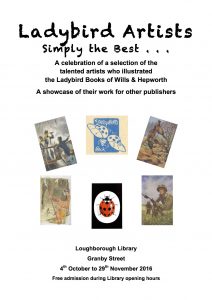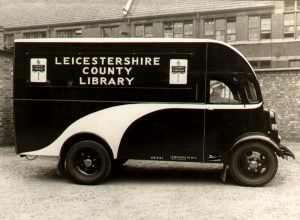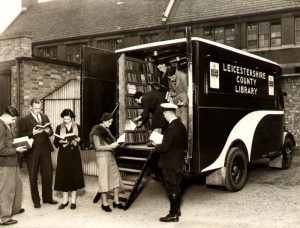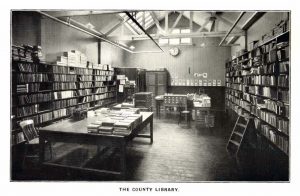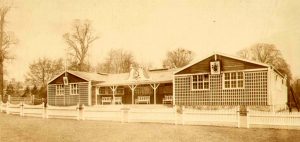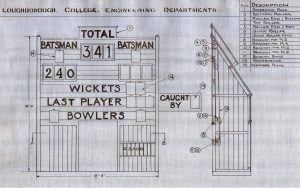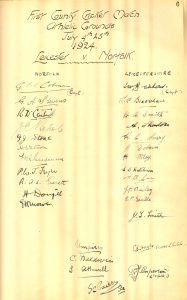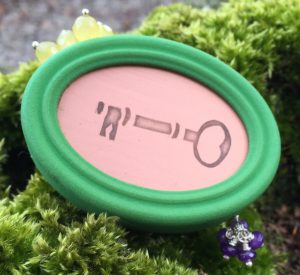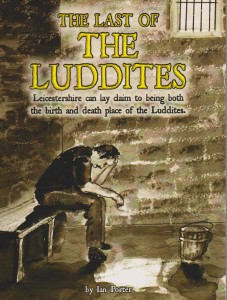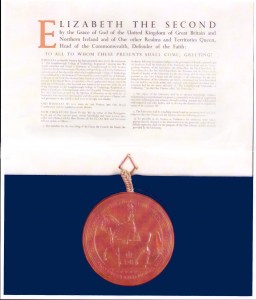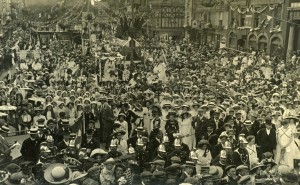Ladybird Artists’ Exhibition – Loughborough Library
10 October 2016
Last week saw the opening of a new exhibition by Local Studies Volunteers at Loughborough Library, which celebrates the work of many artists commissioned by Ladybird Books during their years based in the town.
The internationally renowned children’s book imprint was created in 1915 by Wills & Hepworth, a publishing and printing company with premises in Loughborough’s Market Place. Restricted by paper shortages in the First World War, they designed their small, innovative books to be printed on a single large sheet of paper. Illustrations were commissioned from artists around the country and reproduced for printing by a team of artists employed by the company itself. Wills & Hepworth began trading solely as Ladybird Books in 1971 and was acquired by Penguin in 1999.
You can read here about a talk on illustrating Ladybird Books given at the first Loogabarooga Festival in 2015, which commemorated the company’s link with the town. Find out more about the history of Ladybird Books here.
The exhibition is on display until the 29th November and is free to view during regular Library opening hours.
Alison Mott
Loughborough builds a County-wide Library Service
23 September 2016
Building a County-wide Library Service
In 1922 Loughborough College Principal Herbert Schofield announced that he had secured a grant from the Carnegie UK Trust to set up a county-wide library service with its headquarters at the College. The College Registrar and the Head of the Department Extra Mural Adult Education were designated as honorary librarians. The Leicestershire County Rural Library aimed to provide a circulating library, initially of 10,000 books, to serve the rural areas of the county. Boxes of books would be sent out from the College to local centres like schools and village clubs, and to adult education classes and centres like the YMCA. The College motor van would be used to deliver to thirty centres in a day.
The County Rural Library opened in March 1923 and supplied around 150 centres with books in its first full year, but although the stock was by then over 10,000 volumes and growing, it was ‘far from adequate to meet the needs of a large county’. The report continued: ‘the main demand is for fiction of a rather popular kind, not too fatiguing to the intelligence and somewhat soporific in influence. On the other hand there is a gratifying demand for literature in a great variety of fields.’ Fourteen adult classes had benefited from receiving books and ‘the method of distribution by motor van from Loughborough College has worked out fairly satisfactory, and in point of cost is the cheapest in the kingdom.’ In 1925 the first Sub-Library was opened at Oadby and by 1929 branch libraries had also been established at Hinckley, Melton Mowbray and Ashby de la Zouch.
In 1926 the County and the City of Leicester combined to inaugurate a regional library scheme for Leicestershire. The object of this was that Leicestershire should be a single unit for book supply and library work. This ‘will mark a new era in Library work’, commented the College Calendar. A new Morris delivery van was also acquired. It carried on its side the name of the College Works Manager, J F Driver, and sported gleaming paintwork, with what we might call today a ‘go faster stripe’. It was kitted out with fitted shelves, in all likelihood made in the College workshops, and had a uniformed driver with AA patrolman-style knee-high boots. Deliveries of books were made three times a year to all Library centres working under the scheme.
A county rate was levied to provide funds in 1927 and a full time County Librarian and a special assistant were appointed to catalogue the whole of the library stock. The resulting card catalogue was kept at Library HQ at Loughborough College. By 1929 the word ‘Rural’ had been dropped from the Library’s title and it was known simply as the ‘Leicestershire County Library’. The book store and office, it was reported, had now been rehoused in ‘a suite of rooms specially designed for library work’ (actually one of the huts off Frederick Street), from which the library van was able to collect consignments of books direct. This arrangement continued until the College needed the space for the expanding aeronautical and automobile engineering workshops and in 1935 the County Library HQ, its Librarian, and his three assistants departed Loughborough for more spacious quarters in New Street, Leicester.
Jenny Clark, Loughborough University Archives
‘I Do Love Cricket – It’s So Very English’*
7 September 2016
In late 1919, thanks to the persuasive powers of Loughborough College Principal Herbert Schofield, the County Council bought 14 acres of land on Ashby Road for playing fields. Schofield was able to increase the area within months by purchasing a further parcel of land and acquired another 12 acres in 1921. Levelling the ground and laying out pitches was commenced early on and a cricket pavilion, complete with dressing rooms, shower, slipper bath, lounge, tea room, and even a small gym, was built. A cricket screen and scoring board were designed by the College workshops. The grounds and pavilion were officially opened by Lord Crawshaw of Whatton House on 13th May 1921. This cricket ground was located where the Student’s Union now stands.
By 1923 the playing fields stretched to over 30 acres and besides the cricket pitch included two rugby pitches, two football pitches, a hockey pitch, and grass and hard tennis courts as well. In early 1923 1000 square yards of turf was ordered for the cricket pitch from Leicestershire County Cricket Club at a cost of £41.5s 0d and a concrete practice pitch was also planned ‘to the specification and tender from the College Works Department’. All this work had been completed by June and towards the end of the year the College received a request from Leicestershire CCC for facilities to play Minor County Championship matches at the College ground. It was agreed that the ground would be available for County matches during the 1924 season.
The first ever county cricket match held at the College ground was a Minor Counties championship game between the Leicestershire Second XI and Norfolk, played over two days, July 4th-5th 1924. The College Union agreed to provide tea for the teams on both days and the Leicestershire CCC was to organise catering for the public. While all the Leicestershire players seem to have been professional, Norfolk included three gentlemen amateurs, notably GEE Colman (Eton & Oxford) of the well-known mustard firm. Leicestershire’s best known players were probably the bowlers Horace Snary and Haydon Smith, and the team’s coach, who acted as scorer for the match, was the ex-Surrey and England all-rounder Ernie Hayes, renowned for scoring 276 in a partnership of 371 with Jack Hobbs against Hampshire at the Oval in 1909. Norfolk won the toss and decided to bat. The result? After a shaky start in a generally low scoring game Leicestershire batted well in their second innings and managed to win by six wickets.
Several other Minor Counties matches were played on the College ground in the 1920s as well as two first class games, against Derbyshire in 1928 and Glamorgan in 1929 (see picture here – one of the College’s radio masts, erected a few years earlier, can be seen in the background). However, the increasing cost of preparing suitable pitches and hosting the matches was beyond the means of the College Union and no more county matches, as far as we know, were played on the this ground.
Jenny Clark, Loughborough University Archives
*Sarah Bernhardt
Jack Monk, portrait of a Loughborough Lock-keeper
15 August 2016
Loughborough resident Jennifer Harker shares a canal-side portrait she painted of lock-keeper Jack Monk in the 1970’s
‘Having just bought a second-hand, fibreglass canal cruiser, my husband and I were very fortunate to find a good mooring close to Bishop’s Meadow Lock in Loughborough, where we met the lock-keeper, Jack Monk. His narrowboat, ‘Owl’, was moored just between our boat and the lock. From the moment we met him I knew that I wanted to paint his portrait. His face was full of character and weathered by hard work out of doors. Very obligingly, he stood next to ‘Owl’ which I sketched in roughly as I concentrated on Jack.
Having been born and brought up on the working boats, Jack was very knowledgeable about life on the canals – legging through tunnels, loading and unloading etc. He spoke of horses used on towpaths for pulling barges. One day, Jack invited us on board ‘Owl’. I remember a gorgeous smell coming from a small oven. It was a tray of pork spare ribs cooking for his lunch. One of the interesting decorations in ‘Owl’ was a white glazed pottery plate with holes around the edge through which ribbon was threaded. Everything was ‘squared away and shipshape.’
Working on the canals was a ‘year-round occupation’, when families had to cope with winter rain, ice, snow and fog. It was hard work at the best of times and those with young children must have had a difficult time of it.’
Jennifer Harker, August 2016
Read an article by Loughborough resident David P, himself a canal enthusiast, about the history of canals.
Did you know Jack Monk? Would you like to add your memories to this feature? Email Alison at lboro.history.heritage@gmail.com
Loughborough Jewels: a participatory arts project
8 August 2016
In December 2015 I was invited to take part in a project which aimed to collect people’s memories of Loughborough and use them as a creative stimulus for making jewellery.
The project was carried out by Roberta Bernabei, a lecturer in Contemporary Jewellery and Critical and Historical Studies at Loughborough University, whose creative pieces have been exhibited around the world. Wanting to encourage local participation in the arts, Roberta would take an unusual approach to preserving people’s memories – through the act of wearing jewellery.
So on a sunny winter morning I visited Roberta’s office in LU Arts’ Edward Barnsley building on Epinal Way.
Roberta had asked me to bring along an image, photograph or object relating to a strong personal memory of the town and after some deliberation, I’d chosen a key. I’m a member of Loughborough Archaeological and Historical Society which runs the Old Rectory Museum in Steeple Row and the key is similar to the one we use to unlock its old wooden door. I chose it to symbolize my first visit to the museum one drizzly Saturday many years ago.
Roberta took a photograph of the key and explained she’d be interpreting my memories in the form of a brooch. Then she switched on a digital recorder and invited me to tell her the memory associated with the key. As I talked, she prompted me with questions.
What emotions were linked to the memory? I’d been looking for something to entertain a lively young child and my first feeling was relief at finding the museum open, followed by wonder at its ‘Old Curiosity Shop’ interior. It was packed to the rafters with furniture and pictures and old dusty artefacts and, most significantly, an ancient model railway which drew my son like a magnet. He played happily with it for quite some time, giving me leisure to listen to the old gentleman on duty tell stories of Loughborough in times gone by. Our discussion that day fuelled an interest in local history which would go on to have a significant impact on my life.
Could I recall any particular colours? Roberta asked, and I suddenly thought of the leaves on the trees around the museum, bright green and dripping with rain.
At the end of the interview I gave Roberta a book about the Old Rectory and she asked if I’d like to collect my brooch in person when it was done. I said that I would.
On a Saturday in January 2016 I went along to the unit in Carillon Court Shopping Centre used by LU Arts’ Radar initiative for their ‘Market Town’ project. There I joined fellow interviewees to celebrate with tea and cake and to listen to Roberta describe her jewellery-making process.
Roberta had created each brooch by etching a unique image into a plate – many of them copper – and setting it into a pre-formed coloured mount which ‘framed’ the memory. The brooches were embellished with beadwork to signify the colours, feelings and objects that people had recalled in their stories.
Altogether, Roberta had created ten brooches representing the diverse range of objects and memories participants had shared with her. One person had taken along a locally-printed book she’d enjoyed as a child. Another shared the memory of her wedding bouquet, made entirely from local flowers by a florist on Park Road. One brooch – created for the only man to take part in the project – was inspired by an enthusiasm for the Athletic Grounds which had once stood along Nottingham Road. The gentleman would, he told me, be gifting the brooch to his wife.
As for my brooch, I pinned it to my scarf as I left the exhibition then I headed off to do some shopping. Within half an hour I’d bumped into a friend and told her all about the memory behind the image on the brooch. I’ve told people the story several times since. Before this, I never would have believed a piece of jewellery could hold a town’s history so effectively. I’m rather pleased to find that indeed it can.
Alison Mott
Here is the jewellery Roberta created for the Loughborough Jewels project.
Roberta Bernabei can be contacted at R.Bernabei@lboro.ac.uk
Anyone for Tennis?
12 June 2016
So Wimbledon’s here again with Sue Barker and a team of celebrity commentators on the BBC, including John McEnroe, Martina Navratilova and Tim Henman. Look forward, if you’re there, to queues and controversial calls, tarpaulins and tantrums, rainy days and royalty. That grassy bank by Court No 1 with a view of the big screen – is it still Henman Hill or maybe nowadays Murray Mountain?
The first ever Wimbledon tournament in 1877 was the first organised tennis tournament in the world. Only men’s singles were played until 1884 when women’s singles and men’s doubles were introduced. Women’s doubles and mixed doubles began in 1913.
The commentator for the 1984 Men’s Final was the legendary Dan Maskell, known as ‘the Voice of Wimbledon’. Dan Maskell was Professional Champion of the World sixteen times between 1928 and 1951 and was coach to the British lawn tennis team which won the Davis Cup in 1933. That Davis Cup team included Fred Perry who also won three consecutive Wimbledon titles 1934-36. It was to be 77 years until another British man won Wimbledon, Andy Murray beating Novak Djokovic 6-4, 7-5, 6-4 in 2013.
Dan Maskell’s programme for the 1984 Final was autographed by the two finalists, Jimmy Connors and John McEnroe. Their signatures are faint but Jimmy Connors has added ‘You are the Best’ – which Maskell certainly was. In the final McEnroe beat Connors in straight sets 6-1, 6-1, 6-2. Other players who signed Dan’s programmes over the years include Ken Rosewall, Lew Hoad, Bjorn Borg, and Pat Cash.
During the Second World War Dan Maskell had served as the RAF’s Rehabilitation Officer. He came to Loughborough in 1942 when the RAF Medical Rehabilitation Unit was relocated to Loughborough College, the forerunner of the present university, having been bombed out of its previous quarters in the Palace Hotel in Torquay. Hazlerigg and Rutland Halls provided accommodation and the College swimming pools, gyms, and playing fields were used for rehabilitation.
Among the Physical Training Instructors who served with Dan Maskell at Loughborough were several well-known footballers including Sergeant Raich Carter, an England international who played for Sunderland before the war and Derby County and Hull after the war. When Maskell found he had as many as seven professional footballers as PTIs, he arranged for them to play for Derby County – ‘for every home match a bus would deliver twenty-five of our patients to watch our PTIs running rings round the opposition on the football field’! He also organised a number of charity football matches and tennis tournaments featuring well known players, such as those for Loughborough’s ‘Wings for Victory’ week in 1943 and ‘Salute the Soldier’ week in 1944. By the end of the war over 10,000 airmen had been treated at Loughborough and restored to active duty or civilian life.
The Dan Maskell Collection in Loughborough University Archives includes programmes, photographs and many other tennis related items, and the Dan Maskell Tennis Centre on campus now houses eight indoor courts and the LTA Academy.
Jenny Clark, Loughborough University Archives

Dan Maskell’s programme for the 1984 Wimbledon Final, signed by many of the greatest players of the day, is part of a collection of sporting memorabilia held by Loughborough University Archives.
Watch Pathe News footage of Wings for Victory Week in London in 1943.
The Luddites are Coming! Local exhibition
24 May 2016
When Ned Ludd came to Loughborough: the 200th Anniversary of the Luddite Riots in Loughborough
On Thursday, 2nd June 2016 at Loughborough Library, the exhibition Lace and Luddism opened to commemorate the 200th anniversary of the Luddite attack on Heathcoat and Boden’s mill premises in Loughborough.
On 28th June 1816 sixteen men from Nottingham had been paid to destroy Heathcoat and Boden’s knitting frames. The exhibition will feature examples of the axes, hammers and hatchets that were used. A replica gallows of Leicester’s “New Drop” – where seven of the men were hung – will be on display. For the first time proof will be displayed that Ned Ludd really did exist and not just as the mythical leader of the Luddite movement.
Rare books, maps, examples of the type of lace produced at the time and a painting of the Luddites in action will be on show. Also featured will be the story of those workers who chose to remain as employees of Heathcoat and Boden and walked all the way from Loughborough down to Tiverton in Devon.
The exhibition will run from the beginning of June to the end of July 2016.
*******************
LUDD HUB and PICNIC IN THE PARK 25 JUNE
As part of Loughborough’s birthday celebrations, on Saturday 25th June 2016 in Queen’s Park, Loughborough, there will be a “Ludd Hub” stand where, during the afternoon, a series of Luddite-themed events are planned. The Sherwood Lads will be performing music from the period and a reading of the last words of the men caught and condemned will be given. Lord Byron will make an appearance to recite his maiden speech to the House of Lords, lamenting the utter misery that prevailed among the framework knitters of the Midlands. Come and see lace being made and take the town’s Luddite trail. A free handout explaining the story of Loughborough’s lace-making heritage and its destruction by the Luddites will be available. Two publications, The Lace Makers Story and The Last of the Luddites, will be available for purchase, with a chance to meet the authors. Visitors are encouraged to come dressed in the costume of the time. Take part in the first leg of the re-enactment of the loyal workers’ march to Tiverton in Devon. The ceremonial start to the walk will be conducted by present day descendants of the mill owners John Heathcoat and John Boden. The core group of walkers planning to repeat the walk, are aiming to reach Tiverton within 14 days.
The Ludd Hub is presented by Loughborough Library Local Studies Volunteers in collaboration with Loughborough University’s Department of Politics, History and International Relations.
Loughborough University’s Golden Jubilee
27 April 2016
This year Loughborough University celebrates its 50th birthday. On 19 April 1966 the Queen signed and sealed the royal charter of incorporation that granted university status to Loughborough College of Technology. The new Loughborough University of Technology was the first of the ten Colleges of Advanced Technology to become a university and thus the first technological university in England and Wales. In its first full academic year, 1966-67, the new university had 1742 undergraduates (of whom only 56 were women) and 141 postgraduates. In the academic year 2014/2015, the university had over 16,000 students in all.
Royal Charters or Letters Patent were sealed by appending the Great Seal of England, which has been used since the reign of Edward the Confessor in the eleventh century to authenticate documents of the highest importance. The seals were originally made of beeswax. On one side of the seal (called the obverse) the monarch was shown enthroned and on the other (called the reverse) depicted on horseback. A new Great Seal is made on the ascension of each new monarch.
Modern seals are now made from heated thermoplastic which is poured into a solid silver mould and pneumatically pressed to obtain the imprint of the matrix design. The Great Seal of Queen Elizabeth II attached to the University Charter was designed in 1953. Here is shown the reverse side with the Queen on horseback wearing the uniform of Colonel in Chief of the Grenadier Guards. On the obverse she is shown enthroned, holding the sceptre and the orb. This Great Seal of England was replaced in 2001 and documents issued since under the Great Seal now show the older Queen on the obverse, while on the reverse the image of the Queen on horseback has been replaced by the full royal coat of arms.
Jenny Clark, Loughborough University Archives
Hathern History website
18 April 2016
Check out the village of Hathern’s very own ‘wicked’ heritage website here.
Loughborough Market Place – what was the event?
18 April 2016
This picture of Loughborough market was sent to the network by Gillian Hicks. Email us and let us know if you can help identify the event taking place in it.
